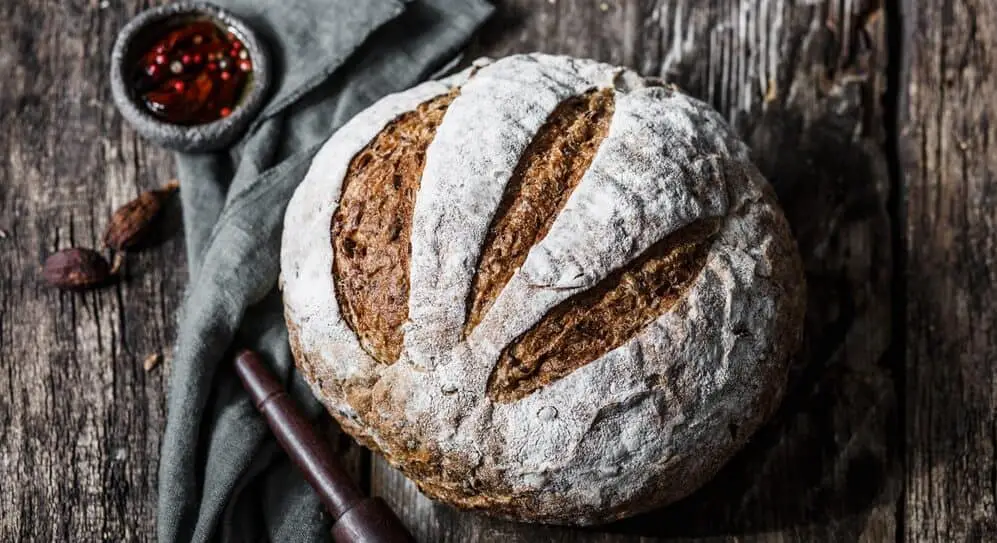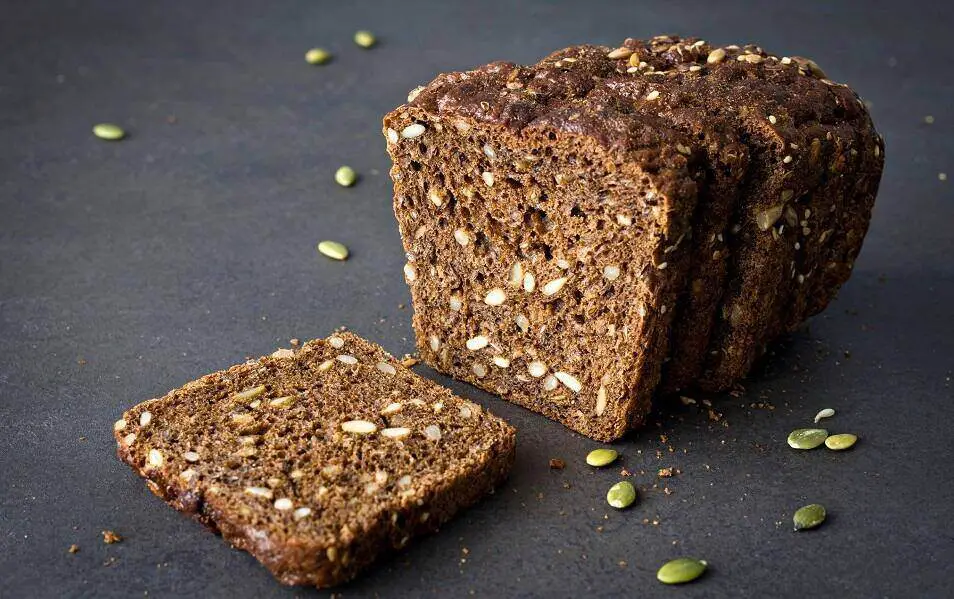There is no clear-cut, standard definition of artisan bread. However, the term typically refers to intricately prepared and baked types of bread. Artisan breads are handmade rather than machine-processed. Sometimes, they are made using traditional techniques passed down to generations.
The preparation process involves long fermentation periods, longer cooking hours at highly regulated temperatures, and the use of high-quality ingredients.
They are usually backed in hearth-style ovens or ovens designed to exhaust and inject steam through a baking chamber like the Dutch oven. However, they can also be cooked in conventional ovens, with a few modifications.
Typically, artisan breads are made with four main natural ingredients: yeast, salt, water, and flour, with a few exceptions. For instance, a starter is required for sourdough loaves, and only water and all-purpose flour are required to make the traditional grissini bread.
However, contemporary artisan breads may include additional ingredients such as eggs, cheese, and malted barley syrup may be included.
Due to the extensive skills, time, and effort required, most artisan bakers make artisan loaves in small batches. The bread is considered superior quality as it has a more complex flavor and better aroma, taste, and texture. Unlike mass-produced loaves with a closed structure, artisan breads have more air pockets and a firmer, well-hydrated crumb.
Generally, artisan loaves have a shorter shelf life and are best consumed fresh. They are more expensive than regular bread.
Common Types of Artisan Bread

Below is a look at the most common types of artisan breads. A majority are French and Italian breads.
Sourdough Bread
As its name suggests, sourdough bread has a sour, tangy taste. It is one of the earliest leavened breads made before the invention of yeast. It was naturally leavened by fermenting flour in water for several days.
However, later variations of the recipe incorporated a starter, usually the lactobacillus bacteria, to initiate the fermenting process. Aside from serving as a starter, the lactobacillus bacteria also enhances the flavor of the bread and matures the flour to make it easy to knead.
The fermenting period varies depending on the artisan baker’s preference. Once adequately fermented, the dough is kneaded and folded by hand. It is then left in a warm environment for at least 12 hours to ferment further. Finally, it is shaped into a loaf and then baked.
To maintain moisture, sourdough bread is typically baked in a Dutch oven. This cooking method ensures a thick, crusty exterior and a soft, hydrated interior.
Bagels
Bagels are doughnut-shaped bread that many people consider one of the artisan bread types. They originate from the Jewish communities of Poland. They are leavened with yeast and have a crisp, shiny crust. The interior is dense and chewy.
It is easy to make using the four main ingredients characteristic of artisan bread—flour, salt, yeast, and water. Most bakers use malt barley syrup in place of sugar to sweeten them.
Bagels are best made with high-protein wheat. Once you have made the dough, shape it into rings. Expert artisans prefer to put the rings away in a cooler for several days in a process known as proofing. Proofing allows the yeast to ferment and release various enzymes that improve the flavor and texture of the bagels.
One of the unique steps of making bagels is boiling them for 30 seconds to one minute before baking. Boiling seals in moisture and softens the gluten to keep the bagels soft. Then, the bagels are baked at high heat until they turn golden brown.
Bagels have become a mainstream pastry across the US and Europe. They are commonly sold in bakeries, coffee shops, restaurants, and grocery stores, with some bakeries specializing in bagels only.
While some sellers are keen to adhere to the traditional method of making artisan bagels, others use machines to make the rings and steam the bagels. They also incorporate various high-quality ingredients, including seeds, spices, eggs, flavorings, sugar, milk, and butter. There are also multigrain and rye bagels available.
Ciabatta
Ciabatta is a type of Italian bread. The term ciabatta means “slipper,” which preempts the shape of the bread—long and squarish. Its interior is soft and chewy with numerous big air holes, while the exterior is crusty and floury. It has a tangy taste but is milder than sourdough.
It is mainly used for making sandwiches and is an excellent option for the panini sandwich. It can also be used as a soup bread, toast, or accompaniment for meat and vegetable stews.
The ciabatta bread is quite easy to make. You only need the four main ingredients for artisan bread, and you do not need any special equipment. The dough is soft and easy to knead.
The only special requirement when baking ciabatta is a high oven temperature with steam to ensure the soft interior and crunchy crust. Place a baking tin with water at the bottom of the oven when baking to produce steam.
It is best enjoyed fresh. Do not leave it at room temperature for more than 12 hours, as it goes stale easily. However, you can refrigerate or freeze it.
Focaccia
Focaccia is yet another Italian artisan bread. It dates back to ancient Rome. It is a flat, leavened bread baked in a hearth oven. It looks like a hybrid of the ciabatta and pizza bread.
Like the ciabatta, it has a chewy interior with numerous holes and a crusty exterior. Since it is thin, it looks like pizza bread. It is considered the prototype for modern pizza. It differs from pizza dough because its recipe incorporates more yeast, so it rises more.
For best results, the dough is proofed for 1-2 hours. It is brushed with generous amounts of olive oil and then topped with your preferred ingredients. The top is punctured before being baked for a perforated finish on the crust. The key is to bake in a hot oven, preheated to 475F. You can also use hearth for baking.
The focaccia bread can be sweet or savory, depending on the topping ingredients used. It is mostly flavored with olive oil and balsamic acid and can be topped with olives, garlic, herbs, and vegetables.
It can be enjoyed in various ways, including on its own, toasted, stuffed, or as a sandwich. A sweet version of the bread can be served as dessert or at breakfast. You can cut it up into different sizes and shapes for easy presentation. It is best enjoyed warm rather than hot or cold.
French Baguette
The French baguette is a classic and iconic French bread. It is a long, thin bread with diagonal slashes. Its interior is dense, while the exterior is crusty. It is made with the four main ingredients and baked on a baking sheet, stone, or U-shaped pan in a high-heat, steam-filled oven.
Once the dough is kneaded, it should be left to rise for 12 hours. Divide the dough and roll the sections into long thin loaves. Cover the loaves with a greased plastic wrap and let them sit for about one hour at room temperature for the dough to rise further.
Hold a sharp knife at 45 degrees and use it to make three to five diagonal slashes on the top side of each French baguette. Then, spray them in water before baking at high heat for 10-15 minutes.
Brioche
Brioche is another French artisan bread. Unlike other artisan breads that use the four main ingredients, it is enriched with butter and eggs. It is light and puffy with a tender interior. The exterior is golden with a flaky crust.
Brioche is popular across the globe and is often used as an alternative to regular bread. It can be enjoyed in various ways, including club sandwiches, burgers, French toast, dessert, etc.
Grissini
Grissini is Italian breadsticks. They have a rich history that dates back to around 1670. They are linked to the childhood of the Duke of Savoy, Vittorio Amedeo II. The then doctor of the ducal Palace had recommended that the duke eats something easily digestible to improve his appetite. A local baker, Antonio Brunero, made breadsticks for the duke.
The breadsticks are made with only flour and water. The two ingredients are mixed into a dough, and then the bread dough is separated into smaller balls. Each ball is rolled with the hands to form a knobby bread stick.
Over time, artisan bakers preferred to flatten the roll to achieve a crispier crust. The rolls are arranged in a baking tray and baked in the oven for 20-25 minutes until they become golden brown. The bread is mainly a crust with minimal interior flesh.
Some bakers incorporate olive oil in their grissini recipe to make the dough more pliable and improve the texture and flavor of the bread. Olive oil also makes the crust crispier. Other variations of the artisanal grissini bread recipe include adding fresh herbs such as rosemary and thyme, sesame or poppy seeds, or salt or pepper.
Traditionally, the bread is served in a large glass placed at the center of the table. People can reach for a stick at a time and crunch away. Or, you can roll it in a slice of ham or dip it in a soup or sauce. You could also crumble it into your soup or broth to thicken it. The breadsticks can last up to 5 days in an airtight container.
Rye Bread

Classic rye bread can be considered artisan bread. It is made of rye flour, active dry yeast, warm water, and salt. Traditionally, it was made in a steam oven, but it can be baked in a regular oven.
It has a tangy, earthy taste, a dense crumb, and a crispy crust. There are numerous modifications to the rye bread recipe. Some people opt to add all-purpose white flour to tone down the intense taste of rye flour. You can also add spices such as cinnamon and nutmeg or caraway seeds.
What Is the Difference Between Artisan and Regular Bread?
The main difference between artisan and regular bread is in the ingredients used, the preparation and the baking method. In most cases, artisan breads are made with yeast, water, salt, and flour, although yeast and salt can be left out.
They are made using traditional methods such as a Dutch oven or hearth. However, most of the recipes can be replicated with a conventional oven. They are mostly handmade, and most recipes require that the dough be left to ferment and proof.
What Is the Difference Between Rustic and Artisan Breads?
There is no clear difference between these two types of breads. Based on their description, most artisan breads are rustic and vice versa. Rustic breads are not shaped with a pan and are cooked at higher temperatures than regular bread. As such, they have a thicker crust. Like artisan bread, they are made with 4 main ingredients — water, flour, salt, and yeast.
Conclusion
There is a narrower range of artisan loaves than regular breads. A majority are French and Italian breads. The most common artisan breads include sourdough bread, French baguettes, ciabatta, focaccia, brioche, and grissini. You can buy artisan loaves at your local artisan bakery or opt for homemade bread. You can vary the traditional recipes slightly to incorporate more ingredients.
